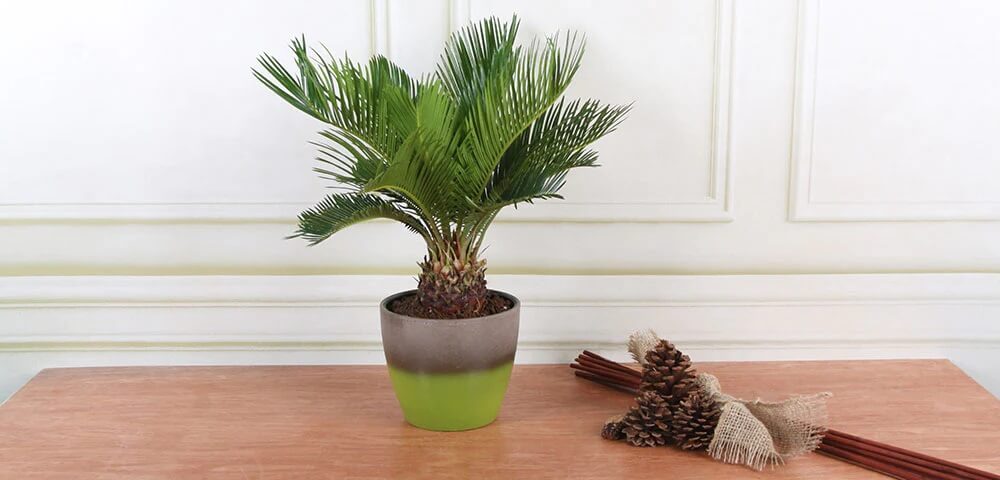Indoor plants are a widespread and practical addition to homes and offices. They offer multiple benefits, both aesthetic and functional. Considerable palm tree varieties, aboriginal to tropical and subtropical regions, provide an unknown touch to indoor spaces. These plants, typically from the palm family (Arecaceae), grow slowly and require little care, making them excellent for interior ornamentation.
However, highly lifelike artificial palm plants are readily unrestricted for those seeking a zero-maintenance alternative. These faux alternatives can completely simulate the beauty of real palm trees, permitting you to enjoy a bold and tropical ambience in your home without requiring regular upkeep. Whether real or fake, palm trees are brilliant for adding a touch of the tropics to your indoor setting.
Chinese Fan Palm

Directed to as the fountain palm or Livistona chinensis, this plant stands out with its star-shaped leaves, a deviation from the typical feathery foliage of common palms. Flourishing in well-lit, avoiding conditions shows strength in partial shade.
With the power to reach 15 feet, the Chinese fan palm is ideal for more ample settings. Contrarily, for more consolidated areas, consider exploring miniature varieties like the dwarf Chinese fan palm and the Taiwan fan palm.
Also Read: How to Grow Swiss Cheese Plant From Seed
Majesty Palm

The majesty palm, scientifically known as Ravenea rivularis, boasts extensive, feather-like fronds that arch upward and a negligibly swollen bottom of its trunk. Varying from many drought-resistant palm species, this one comes from the wet provinces of Madagascar, favouring unfailingly moist soil without existing waterlogging. Understood for its rapid growth, a fully evolved majesty palm can attain heights of up to 15 feet. It thrives when exposed to bright, indirect sunlight but can adjust to partial shade.
Also Read:How to Grow and Care for Majesty Palm?
Cascade Palm

Unlike particular palm trees characterized by a prominent trunk, Chamaedorea cataractarum is a dense palm variety comprising clusters of fronds that can reach 6 feet. As the tufts mature, you can divide them, creating new plant material for propagation through detachment. The cascade palm thrives near streams and damp lowland regions in its natural environment, necessitating regular watering when cultivated indoors. Fortunately, cascade palms are
well-suited for indoor cultivation as they are acclimated to thriving in low-light circumstances as understory plants.
Also Read: How to Grow Pink Princess Philodendron
Kentia Palm

If you choose a “plant it and forget it” option, the Howea forsteriana, also known as the Kentia palm, is an immaculate choice. Once established, it requires minimal attention and is rated one of the most accessible and least challenging equatorial plants to produce. This Kentia palm, characterized by its slow growth, showcases an exceptional adaptability to diverse conditions. It succeeds in the shade, survives cold temperatures, and seldom overgrows its assigned space. Typically, it’s available in packs of three or more plants within a single pot,
delivering a lush and complete impression.
Sago Palm

If you’re new to indoor palm plants and your first encounter with the sago palm, you’re in for a pleasant experience. It features severe fronds that grow vertically from a stubby, textured compartment reminiscent of a pineapple. When picking an indoor spot for it, opt for a place that welcomes dappled sunlight for around four to six hours daily. The sago palm blossoms with consistent and routine moisture, but ensuring the soil surface is nearly dry between watering sessions is required.
Areca Palm

The Dypsis lutescens, typically known as the butterfly or bamboo palm, functions as a striking centrepiece in ample rooms, with typical sizes of around 5 feet available in garden centres. These palms are an excellent option for people pursuing an indoor tree-like plant. With good care and exposure to bright, indirect sunlight, the areca palm can reach heights of up to 8 feet. Nevertheless, it can also acclimate to medium-light conditions. Consideration should be taken to dodge overwatering; permit the soil to dry out before the following watering session.
Also Read: How to Grow and Care for Polka Dot Plant
Parlor Palm

Chamaedorea elegans, the charming parlor palm, is cherished for its lush, clumping impression reminiscent of a bamboo grove. A treasured houseplant for five decades, it stands as one of the most favoured indoor palm sorts. This palm’s leisurely development rate and general ease of care make it an immaculate option for indoor cultivation. In its untouched environment, it can reach heights of 12 feet, but indoors, it typically comes between 2 and 6 feet. The parlour palm is relatively susceptible to low-light conditions but displays slower development as a trade-off.
Yucca Palm

Accuracy is vital for indoor palm plant identification, particularly for yucca palms. Yucca aloifolia, the Spanish bayonet, is characterized by its sharp and spiky leaves, making it more suitable for outdoor settings. On the other hand, Yucca elephantipes, the spineless yucca palm, has characteristic leaves with pointed tips, but it’s far less likely to induce injury compared to its spiky relative. You might experience the indoor yucca palm under the “stick yucca.” These sturdy plants showcase sturdy, strap-like green leaves from an attractive trunk. They display exceptional drought toleration and prosper from full sun to partisan shade.
Also Read: 18 Indoor Plants with Big Leaves
Pygmy Date Palm

In distinction to its relatives, which can soar to 75 feet in their natural surroundings, the Phoenix roebelenii is a small palm variety indigenous to southern China. This palm, known by different names such as the miniature date palm, dwarf date palm, pygmy date palm, miniature date palm, and robellini palm, generally grows to a mediocre 3 to 5 feet when produced indoors. It is decorated with slender, feathery leaves in glossy, silvery, or dark green shades. While drought-resistant, it can tolerate light frosts outdoors during the summer but cannot resist a stringent freeze.
Ponytail Palm

For those pursuing a low-maintenance palm-like plant that does not grow excessively large, Beaucarnea recurvata is an exceptional choice. Its appealing foliage emerges from a swollen trunk, resembling a cheerful ponytail. Despite its palm-like appearance, it’s not a true palm but a component of the Asparagaceae family.
The ponytail palm’s robust trunk allows it to store water, leaving it with extraordinary drought tolerance. It thrives in well-lit, indirect sunlight and is satisfied with a snug pot. Its packed size makes it flawless for standing on a plant stand, enhancing its embellishing appeal.
Also Read:How to Grow Dragon Tree (Dracaena marginata) Indoors?
Indoor Palm Tree Care Essentials
Light:
Most indoor palms flourish in bright, indirect light, dodging direct sunlight to control leaf scorching. Low-light spaces may help grow lights.
Temperature and Humidity:
Hold temperatures between 65-75°F and deliver moderate humidity. Use a humidifier or mist the plant if your indoor atmosphere is too arid.
Soil:
Well-draining, negligibly acidic or neutral potting soil functions well. Evade topsoil or yard soil. Ponder adding peat moss and vermiculite for water retention.
Watering:
Maintain damp but not waterlogged soil, allowing the top inch to dry before watering. Assure pots have drainage holes to control root rot. Accommodate watering the plants with the seasons.
Feeding:
Use particular indoor palm fertilizers during the growing since indoor palms are not serious feeders.
Propagation:
Palms are efficiently multiplied through a separator during repotting in the spring.
Also Read: How to Care for String of Pearls Plants
FAQ’s
1. What is the most suitable place for my indoor palm tree?
Most indoor palms flourish in bright, avoiding light. Some can abide by lower light situations. Bypass natural sunlight to control leaf scorching.
2. When and how should I fertilize my indoor palm tree?
Fertilize with a distinctive indoor palm fertilizer during the increasing season. Follow the instructions on the development label for accurate application.
3. Can I propagate my indoor palm tree, and how do I do it?
Palms are often propagated through separators during repotting. Divide the plant at the root level and replant the units in different pots.
4. Can I grow numerous palm trees in the same pot?
Occasionally, you can produce numerous palms in an identical pot, but be cautious about overcrowding. Guarantee there’s sufficient space and soil nutrients for each plant to flourish.
5. Which indoor palm tree is the easiest to care for?
Some of the most effortless indoor palm tree species to manage for retention are the parlor palm (Chamaedorea elegans), the ponytail palm (Beaucarnea recurvata), and the areca palm (Dypsis lutescens).











